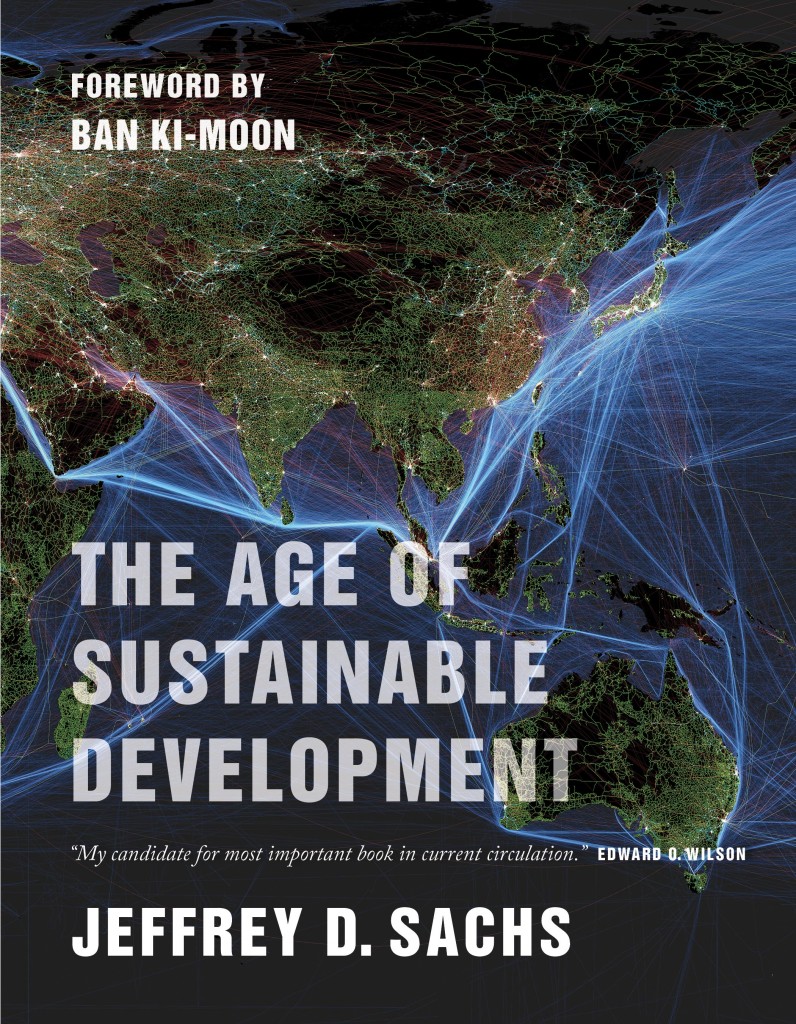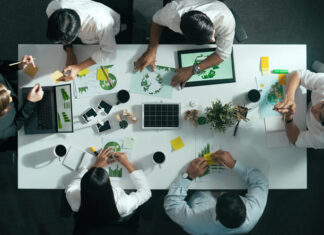Achieving sustainable development on our crowded, unequal, and degraded planet is the most important challenge facing our generation. In this excerpt from the book “The Age of Sustainable Development”, Jeffrey D. Sachs introduces the concept of sustainable development and its normative outlook on the world.
Sustainable development is a central concept for our age. It is both a way of understanding the world and a method for solving global problems. Sustainable Development Goals (SDGs) will guide the world’s economic diplomacy in the coming generation. This book offers you an introduction to this fascinating and vital field of thought and action.
Our starting point is our crowded planet. There are now 7.2 billion people on the planet, roughly 9 times the 800 million people estimated to have lived in 1750, at the start of the Industrial Revolution. The world population continues to rise rapidly, by around 75 million people per year. Soon enough there will be 8 billion by the 2020s, and perhaps 9 billion by the early 2040s (Sustainable Development Solutions Network [SDSN] 2013a, 2, 5).
These billions of people are looking for their foothold in the world economy. The poor are struggling to find the food, safe water, health care, and shelter they need for mere survival. Those just above the poverty line are looking for improved prosperity and a brighter future for their children.
Those in the high-income world are hoping that technological advances will offer them and their families even higher levels of wellbeing. It seems that the superrich also jostle for their place in the world’s rankings of richest people.
In short, 7.2 billion people are looking for economic improvement. They are doing so in a world economy that is increasingly interconnected through trade, finance, technologies, production flows, migration, and social networks. The scale of the world economy, now estimated to produce $90 trillion of output per year (a sum called the gross world product, or GWP), is unprecedented (SDSN 2013a, 2). By crude statistics, the GWP measures at least 200 times larger than back in 1750. In truth, such a comparison is difficult to make, since much of the world economy today consists of goods and services that did not even exist 250 years ago.
[ms-protect-content id=”9932″]What we know is that the world economy is vast, growing rapidly (by 3-4 percent per year in scale), and highly unequal in the distribution of income within countries and between countries. Ours is a world of fabulous wealth and extreme poverty: billions of people enjoy longevity and good health unimaginable in previous generations, yet at least 1 billion people live in such abject poverty that they struggle for mere survival every day. The poorest of the poor face the daily life-and-death challenges of insufficient nutrition, lack of health care, unsafe shelter, and the lack of safe drinking water and sanitation.
The world economy is not only remarkably unequal but also remarkably threatening to Earth itself. Like all living species, humanity depends on nature for food and water, materials for survival, and safety from dire environmental threats, such as epidemics and natural catastrophes. Yet for a species that depends on the beneficence of nature, or on what the scientists call “environmental services,” we are doing a poor job of protecting the physical basis of our very survival! The gigantic world economy is creating a gigantic environmental crisis, one that threatens the lives and wellbeing of billions of people and the survival of millions of other species on the planet, if not our own.
if not our own.
The environmental threats, we shall learn, are arising on several fronts. Humanity is changing Earth’s climate, the availability of fresh water, the oceans’ chemistry, and the habitats of other species. These impacts are now so large that Earth itself is undergoing unmistakable changes in the functioning of key processes – such as the cycles of water, nitrogen, and carbon – upon which life depends. We don’t know the precise scaling, timing, and implications of these changes, but we do know enough to understand that they are extremely dangerous and unprecedented in the span of humanity’s 10,000 years of civilization.
Thus we arrive at sustainable development. As an intellectual pursuit, sustainable development tries to make sense of the interactions of three complex systems: the world economy, the global society, and the Earth’s physical environment. How does an economy of 7.2 billion people and $90 trillion gross world output change over time? What causes economic growth? Why does poverty persist? What happens when billions of people are suddenly interconnected through markets, technology, finance, and social networks? How does a global society of such inequality of income, wealth, and power function? Can the poor escape their fate? Can human trust and sympathy surmount the divisions of class and power? And what happens when the world economy is on a collision course with the physical environment? Is there a way to change course, a way to combine economic development with environmental sustainability?
Sustainable development is also a normative outlook on the world, meaning that it recommends a set of goals to which the world should aspire. The world’s nations will adopt SDGs precisely to help guide the future course of economic and social development on the planet. In this normative (or ethical) sense, sustainable development calls for a world in which economic progress is widespread; extreme poverty is eliminated; social trust is encouraged through policies that strengthen the community; and the environment is protected from human-induced degradation. Notice that sustainable development recommends a holistic framework, in which society aims for economic, social, and environmental goals. Sometimes the following shorthand is used: SDGs call for socially inclusive and environmentally sustainable economic growth.
To achieve the economic, social, and environmental objectives of the SDGs, a fourth objective must also be achieved: good governance. Governments must carry out many core functions to enable societies to prosper. Among these core functions of government are the provision of social services such as health care and education; the provision of infrastructure such as roads, ports, and power; the protection of individuals from crime and violence; the promotion of basic science and new technologies; and the implementation of regulations to protect the environment. Of course, this list is just a brief subset of what people around the world hope for from their governments. In fact, all too often they get the reverse: corruption, war, and an absence of public services.
In our world today, good governance cannot refer only to governments. The world’s multinational companies are often the most powerful actors. Our wellbeing depends on these powerful companies obeying the law, respecting the natural environment, and helping the communities in which they operate, especially to help eradicate extreme poverty. Yet as with governments, reality is often the reverse. Multinational companies are often the agents of public corruption, bribing officials to bend regulations or tax policies in their favor and engaging in tax evasion, money laundering, and reckless environmental damage.
Thus the normative side of sustainable development envisions four basic objectives of a good society: economic prosperity; social inclusion and cohesion; environmental sustainability; and good governance by major social actors, including governments and business. It’s a lot to ask for, and there is no shortage of challenges to achieving sustainable development in practice. Yet the stakes are high. Achieving sustainable development on our crowded, unequal, and degraded planet is the most important challenge facing our generation. The SDGs must be the compass, the lodestar, for the future development of the planet during the period 2015 to mid-century.
Before proceeding further, let me give a very brief history of the concept of sustainable development. The term “sustainable” as applied to ecosystems goes back a long way. Fisheries managers, for example, have long used the concept of the “maximum sustainable yield” to denote the maximum fish catch per year consistent with a stable fish population. In 1972, at the UN Conference on the Human Environment in Stockholm, the challenge of maintaining sustainability in the context of economic growth and development was first brought to the global forefront. That same year, the blockbuster book Limits to Growth, published by the Club of Rome, argued forcefully that continued economic growth on the prevailing economic patterns would collide with the Earth’s finite resources, leading to a future overshoot and collapse.
While 1972 put the challenge of sustainable development onto the global stage, the phrase itself was introduced eight years later, in an influential publication entitled World Conservation Strategy: Living Resource Conservation for Sustainable Development (1980). This pathbreaking publication noted in its foreword that:
Human beings, in their quest for economic development and enjoyment of the riches of nature, must come to terms with the reality of resource limitation and the carrying capacity of ecosystems, and must take account of the needs of future generations.
The purpose of the document was to “help advance the achievement of sustainable development through the conservation of living resources” (iv).
The phrase was then adopted and popularized in the report of the United Nations Commission on Environment and Development, known widely by the name of its chairwoman, Gro Harlem Brundtland. The Brundtland Commission gave a classic definition of the concept of sustainable development, one that was used for the next twenty-five years:
Sustainable Development is development that meets the needs of the present without compromising the ability of future generations to meet their own needs. (Brundtland 1987, 41).
This “intergenerational” concept of sustainable development was widely adopted, including at the Rio Earth Summit in 1992. One of the key principles of the Rio Declaration was that “development today must not threaten the needs of present and future generations.”
Over time, however, the definition of sustainable development evolved into a more practical approach, focusing less on intergenerational needs and more on the holistic approach linking economic development, social inclusion, and environmental sustainability. In 2002, at the UN World Summit on Sustainable Development (WSSD) in Johannesburg, the WSSD Plan of Implementation spoke of “the integration of the three components of sustainable development – economic development, social development and environmental protection – as interdependent and mutually reinforcing pillars” (World Summit on Sustainable Development 2002, 2). The concept of intergenerational justice remains but is now secondary to the emphasis on holistic development that embraces economic, social, and environmental objectives.
This three-part vision of sustainable development was again emphasized on the twentieth anniversary of the Rio Summit. In the final outcome document for the Rio+20 Summit (“The Future We Want”), the aim of sustainable development was put this way:
We also reaffirm the need to achieve sustainable development by: promoting sustained, inclusive and equitable economic growth, creating greater opportunities for all, reducing inequalities, raising basic standards of living; fostering equitable social development and inclusion; and promoting integrated and sustainable management of natural resources and ecosystems that supports inter alia economic, social and human development while facilitating ecosystem conservation, regeneration and restoration and resilience in the face of new and emerging challenges. (UN General Assembly 2012, para. 4)
The SDGs, called for in the same outcome document, are to be based on the three-part framework. Here is how the SDGs were announced in “The Future We Want”:
[The SDGs] should address and incorporate in a balanced way all three dimensions of sustainable development and their inter-linkages… We also underscore that SDGs should be action-oriented, concise and easy to communicate, limited in number, aspirational, global in nature and universally applicable to all countries while taking into account different national realities, capacities and levels of development and respecting national policies and priorities… Governments should drive implementation [of the SDGs] with the active involvement of all relevant stakeholders, as appropriate. (UN General Assembly 2012, paras. 246-7)
I will discuss the SDGs in greater detail in the final chapter. Until then, I will use the concept of sustainable development in the current sense of a three-way normative framework, embracing economic development, social inclusion, and environmental sustainability. In addition, I will refer to sustainable development as an analytical field of study, one that aims to explain and predict the complex and nonlinear interactions of human and natural systems. I turn next to this analytical sense of the term.
Embracing Complexity
In addition to being a normative (ethical) concept, sustainable development is also a science of complex systems. A system is a group of interacting components that together with the rules for their interaction constitute an interconnected whole. The brain is a system of interacting neurons; the human body is a system of some 10 trillion individual cells, with those cells interacting in systematic ways in various organ systems (circulatory system, nervous system, digestive system, etc.); the cell itself is a system of interacting organelles; and the economy is a system of millions of individuals and businesses, bound together in markets, contracts, laws, public services, and regulations.
We talk about these systems as complex because their interactions give rise to behaviors and patterns that are not easily discernible from the underlying components themselves. The conscious brain cannot be reduced to a list of its neurons and neurotransmitters; functions such as consciousness depend on highly complex interactions of the component neurons. A living cell is more than the sum of the nucleus, ribosomes, and other components; the systems of metabolism, gene expression, and the like depend on highly complex interactions of the components. A growing economy is more than the sum of its individual businesses and workers. Complexity scientists speak of the emergent properties of a complex system, meaning those characteristics that emerge from the interactions of the components to produce something that is “more than the sum of its parts.”
Complex systems have many unexpected characteristics. They often respond in a nonlinear way to shocks or changes, meaning that even a modest change in the components of the system can cause a large, perhaps catastrophic change in the performance of the system as a whole. A small change in the cell’s chemistry can lead to its death; a small change in the physical environment may cause large and cascading changes to the relative abundance of the species in that environment. The failure of a single business can lead to a financial panic and a global downturn, such as occurred when the Lehman Brothers investment bank failed in September 2008. A single bank failure, or a single infection, or a slight change in Earth’s temperature, can lead to a chain reaction, positive-feedback process, which has explosive consequences.
Sustainable development involves not just one but four complex interacting systems. It deals with a global economy that now spans every part of the world; it focuses on social interactions of trust, ethics, inequality, and social support networks in communities (including new global online communities made possible by revolutions in the information and communications technologies, or ICTs); it analyzes the changes to complex Earth systems such as climate and ecosystems; and it studies the problems of governance, including the performance of governments and businesses. In each of these complex systems – economic, social, environmental, and governance – the special properties of complex systems, such as emergent behavior and strong, nonlinear dynamics (including booms and busts), are all too apparent.
Complex systems require a certain complexity of thinking as well. It is a mistake to believe that the world’s sustainable development problems can be boiled down to one idea or one solution. A complex phenomenon such as poverty in the midst of plenty has many causes that defy a single diagnosis or prescription, just as in the cases of environmental ills or communities torn asunder by mistrust and violence. Medical doctors are trained to understand and respond to the complex system known as the human body. Medical doctors know that a fever or a pain can have countless causes. Part of the job of a skilled medical doctor is to make a differential diagnosis of the specific cause of a fever in a particular patient. A skilled sustainable development practitioner needs to be a complex-systems expert in the same way, acknowledging the complexity of the issues and looking to make a specific diagnosis of each specific case.
 Excerpted from The Age of Sustainable Development by Jeffrey D. Sachs. © 2015 Jeffrey D. Sachs. Used by arrangement with the Publisher. All rights reserved.
Excerpted from The Age of Sustainable Development by Jeffrey D. Sachs. © 2015 Jeffrey D. Sachs. Used by arrangement with the Publisher. All rights reserved.
About the Author
 Jeffrey D. Sachs is a world-renowned economics professor, leader in sustainable development, senior UN advisor, best-selling author, and syndicated columnist. He serves as the director of the Earth Institute, Quetelet Professor of Sustainable Development, and professor of health policy and management at Columbia University. He is special advisor to Secretary-General Ban Ki-moon of the United Nations on the Millennium Development Goals, and he held the same position under Secretary-General Kofi Annan. He is director of the UN Sustainable Development Solutions Network as well as cofounder and director of the Millennium Villages Project. (Photograph by Wade Martzall)
Jeffrey D. Sachs is a world-renowned economics professor, leader in sustainable development, senior UN advisor, best-selling author, and syndicated columnist. He serves as the director of the Earth Institute, Quetelet Professor of Sustainable Development, and professor of health policy and management at Columbia University. He is special advisor to Secretary-General Ban Ki-moon of the United Nations on the Millennium Development Goals, and he held the same position under Secretary-General Kofi Annan. He is director of the UN Sustainable Development Solutions Network as well as cofounder and director of the Millennium Villages Project. (Photograph by Wade Martzall)
[/ms-protect-content]



























![“Does Everyone Hear Me OK?”: How to Lead Virtual Teams Effectively iStock-1438575049 (1) [Converted]](https://www.europeanbusinessreview.com/wp-content/uploads/2024/11/iStock-1438575049-1-Converted-100x70.jpg)




